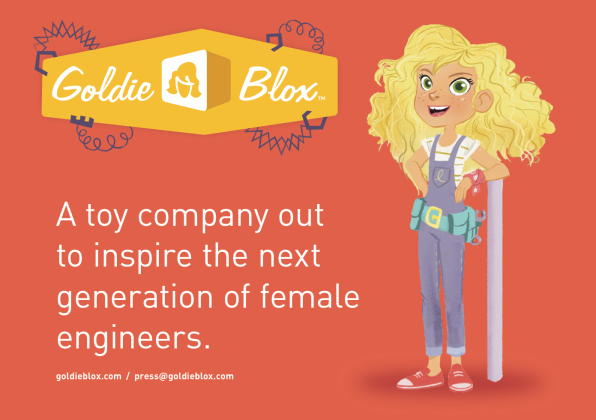A white, thin, blonde-haired doll is hardly groundbreaking.
I want to like GoldieBlox, the relatively new toy company for girls, whose goal is “to get girls building” and “to help level the playing field in every sense of the phrase.” I really do, but their advertising keeps giving me mixed messages.
Even as the mother of a boy, the first time I heard the knock-off of the Beastie Boys song “Girls” featuring girls, aged about 6-8, making Rube Goldberg-esque creations of their “princess” toys with GoldieBlox building sets, I got a little excited. (The Beastie Boys, however, were displeased by the use of their song, and sued GoldieBlox last year, so if you search for the commercial now the song has been changed to a non-lyric based, but still catchy little tune.) Aside from the obvious fact that I was hooked by the music, I thought my enthusiasm stemmed from seeing true innovation in toys for girls.
But quickly my excitement faded as I realized their concept wasn’t very innovative. GoldieBlox still relies upon a differentiation between the genders. Toys for girls, not just toys. Again, even as I encourage and laud their mission to “change the equation” and “disrupt the pink aisle and inspire the future generation of female engineers,” it rings a little hollow.
Want to disrupt the gendered equation for toys? Try Waldorf toys—toys designed in the style of the Waldorf Method’s founder, Rudolf Steiner. He believed that toys should be as unformed and with as few details as possible, to stimulate children’s imaginations. The simpler the better. Many Waldorf toys are made from wood, and other natural fibers, with very little color. And every time my son gets a new Lego kit carefully paired with the movie or television show its promoting (Lego Batman, Lego Chima, Lego Avengers), I have the same thought: whatever happened to plain old Legos, where kids reached into the universes of their own minds to decide what to build out of rectangular pieces in primary colors?
Steiner also believed that play was a child’s version of “work” and toys were her tools. In that regard, any toy could become a tool, whether it resembles a set of blocks (or blox) or not.
Still, I remained watchful and hopeful that GoldieBlox, being new, was in a process of evolution, good to their mission. And then last week I caught wind of one of my favorite songs by Metric, “Help I’m Alive,” whose chorus repeats, “My heart beats like a hammer.” I glanced up to catch another GoldieBlox commercial in action (they are masters of using music to manipulate your emotions): a bevy of young girls wearing all pink clothing and sparkly, heeled shoes, taking a stock “Barbie” off an assembly line and then stepping onto a conveyor belt while the female face of “Big Sister” repeats the words, “You are beauty. Beauty is perfection.” in a creepy monotone. They are then “processed” into said beauty machine in what I’ve read is supposed to be an homage to a 1984 Apple commercial. But it seems more like a rip-off of the “Another Brick in The Wall” (starts about 3:35 in) children-into-the-meat-machine scene from Pink Floyd’sThe Wall.
And guess what? One of these carbon copy girls is different! She’s wearing blue overalls and a toolbelt, with a big mane of bushy blonde hair. She rushes to the machine with her hammer and pounds it apart, to the delight of her pink-clad peers. Sparks fly, the girls cheer their savior, and the following text appears on the screen:
In 2014 GoldieBlox breaks the mold with an action figure for girls.
I have to admit, I got a little excited! What were they going to offer girls, after all that build up? An African-American engineer? A Latina Congresswoman?
Wait for it. Wait for it!
Nope. A golden-haired, fair-skinned, tiny-waisted doll who reminds me a lot of Barbie’s sidekick Skipper from the ’80s. OK, I get that GoldieBlox is aiming for thematic cohesion by making “Goldie’s” hair gold. And yes, Goldie the “action figure” is in overalls which do not bare much skin or sexualize her. And yes, she holds that emblematic hammer—perhaps ready to blast apart gender stereotypes or the glass ceiling—but I was really hoping for a figure that minority girls could see themselves in.
At the very least, she could be a brunette. Or reflect differently-sized girls, with proud runner’s thighs, strong, athletic arms, or the swell of a belly that even skinny girls have. Or a doll who is multi-faceted in her talents: she builds, she swims, dances, and paints—after all, studies have shown that kids who engage in the arts also perform better in math. How about giving her a book?
And that’s when I remembered that GoldieBlox may be disrupting the pink aisle with their mostly non-pink packaging (though they do slip some in), but they’re still out to make the green of profit, after all.
Jordan Rosenfeld is author of the writing guides Make a Scene, Write Free, and the novels Forged in Grace, and Night Oracle. Her essays have appeared or are forthcoming in: Brain, Child, Modern Loss, The Rumpus, the St. Petersburg Times, San Francisco Chronicle and more.
Related Links:

